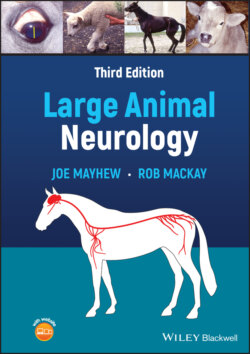Читать книгу Large Animal Neurology - Joe Mayhew - Страница 39
Facial nerve—CN VII
ОглавлениеThis is predominantly a motor nerve innervating the muscles of facial expression, as well as the lachrymal and certain salivary glands. It contains the final motor neurons for movement of the ears, eyelids, lips, and nostrils, including the motor pathways of the menace, palpebral and corneal reflexes. Unilateral facial paralysis is generally seen as drooping of an ear, ptosis of an upper eyelid, drooping of the upper lip, and pulling of the affected nostril toward the unaffected side. General inspection of the symmetry of facial expression is useful. Some normal horses have an asymmetric contour of the external nares and slight deviation of the nostrils to one side. Very close inspection is required in production animals to detect a partial facial paresis because of the presence of collagenous facial structures compared to horses. Comparison of tone in the ears, eyelids, and lips on each side helps to detect facial weakness, especially when the patient is relaxed. Occasionally, a small amount of food may remain in the cheeks on an affected side. This must not be confused with difficulties with swallowing that result from sensory and/or motor trigeminal paralysis and from pharyngeal dysfunction. Because of a lack of muscle tone in cheek and lips, saliva may drool from the commissure of the lips with facial paralysis. If only weakness of the lips and a deviated nasal philtrum without a drooped ear and ptosis occur, probably only the buccal branches along the side of the face are involved. Mild weakness of facial muscles can often be felt rather than seen and will also become more evident when the patient is resting quietly or has been tranquilized. Involvement of one or two, but not all three branches of the facial nerve more commonly occurs with peripheral facial nerve diseases such as polyneuritis or head trauma. However, central lesions can selectively involve individual regions of the facial nucleus thus mimicking peripheral nerve disease, at least in diseases such as equine protozoal myeloencephalitis and listeriosis.
As with other cranial nerves, a diagnosis of CNS disease, compared to peripheral nerve involvement, can be made by identifying involvement of adjacent structures in the medulla oblongata when signs such as lethargy, limb weakness and ataxia, and a head tilt will often result. With lesions of the inner ear, which cause vestibular signs, there is often accompanying facial nerve paralysis because of concurrent middle ear involvement, and the facial nerve is only separated from the tympanic cavity by a thin membrane. Lack of any involvement of other central pathways is used to differentiate signs of such peripheral facial and vestibular nerve disease from involvement of their nuclei and their pathways in the medulla oblongata. Exquisitely focal lesions resulting from agents such as Sarcosystis neurona and Listeria monocytogenes can exceptionally destroy single and multiple central nuclear regions causing signs of selective cranial nerve dysfunction without producing clinical evidence of adjacent brainstem involvement, thereby mimicking peripheral cranial nerve disease.
Of some note here is involvement of the parasympathetic greater petrosal branch of the facial nerve innervating the lacrimal gland. Lesions affecting this component of the facial nerve anywhere from the medulla oblongata to the back of the eye often result in a dry eye. Subsequent development of keratoconjunctivitis sicca can mean the loss of an eye, making early detection of such a sign most important.
With various thalamic and cerebral lesions in horses, the facial muscles may be hypertonic and facial reflexes may be hyperactive, resulting in spontaneous and reflexive grimacing of the face. This is due to the involvement of the central motor pathway controlling facial movement that normally influences the facial nucleus and facial reflexes. Importantly, even in the presence of poor facial expression and control, the facial reflexes are still intact and may be hyperactive. Irritative lesions, such as viral encephalitis, meningitis, and facial neuritis, can also cause spontaneous and reflexly induced facial grimacing.
